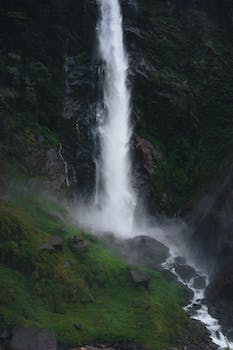

-
Table of Contents
Discover the wonders of the Great American Fall Line in just one minute!
Introduction
The Great American Fall Line is a significant geographic feature that stretches across the eastern United States. It marks the boundary between the coastal plain and the Piedmont region, creating a distinct transition in landforms and waterways. This one-minute geography lesson will explore the characteristics and importance of the Great American Fall Line.
The Formation and Significance of the Great American Fall Line
The Great American Fall Line is a significant geographical feature that stretches across the eastern United States. It is a natural boundary that separates the coastal plain from the Piedmont region. This line runs from New York to Alabama, passing through major cities such as Philadelphia, Baltimore, and Washington, D.C. The formation of the Fall Line is a result of millions of years of geological processes.
The Fall Line was formed during the Paleozoic Era, around 300 million years ago. At that time, the eastern part of North America was covered by a shallow sea. Over time, sediments from rivers and streams flowing into the sea accumulated and formed layers of sedimentary rock. These layers were then uplifted and folded due to tectonic forces, creating the Appalachian Mountains.
As the mountains rose, the rivers and streams that flowed from the mountains began to erode the softer sedimentary rocks. This erosion process created a steep drop in elevation, resulting in waterfalls and rapids along the rivers. These waterfalls and rapids mark the location of the Fall Line.
The Fall Line has played a significant role in the development of the eastern United States. In the early days of European colonization, the Fall Line served as a natural barrier for navigation. Ships traveling up the rivers from the coast had to stop at the Fall Line due to the impassable waterfalls and rapids. This forced settlers to establish towns and trading posts along the Fall Line, leading to the development of cities such as Richmond, Virginia, and Columbia, South Carolina.
The Fall Line also played a crucial role in the industrialization of the eastern United States. The waterfalls and rapids provided a source of power for early factories and mills. Textile mills, sawmills, and gristmills were built along the Fall Line, taking advantage of the water's energy to drive machinery. This led to the growth of manufacturing and the establishment of industrial centers in cities like Lowell, Massachusetts, and Manchester, New Hampshire.
Today, the Fall Line continues to be significant in terms of water resources and recreation. The rivers along the Fall Line provide drinking water for millions of people and support diverse ecosystems. The waterfalls and rapids also attract outdoor enthusiasts who enjoy activities such as kayaking, canoeing, and fishing.
In conclusion, the Great American Fall Line is a geological feature that separates the coastal plain from the Piedmont region in the eastern United States. Its formation can be traced back to millions of years ago when the Appalachian Mountains were uplifted and folded. The Fall Line has played a crucial role in the history and development of the eastern United States, serving as a natural barrier for navigation and providing a source of power for early industries. Today, it continues to be significant in terms of water resources and recreational activities.
Exploring the Natural Features Along the Great American Fall Line

The Great American Fall Line is a prominent geographic feature that stretches across the eastern United States. It is a natural boundary that separates the coastal plain from the Piedmont region. This line, which runs from New York to Alabama, is marked by a series of waterfalls and rapids that were once obstacles for early settlers and traders. Today, these natural features offer a glimpse into the rich history and diverse landscapes of the region.
One of the most famous waterfalls along the Great American Fall Line is Niagara Falls. Located on the border between the United States and Canada, Niagara Falls is a breathtaking sight to behold. The sheer power and beauty of the falls attract millions of visitors each year. Standing at the edge of the falls, one can feel the mist on their face and hear the thunderous roar of the water as it cascades over the edge. It is truly a natural wonder that should not be missed.
Moving south along the Fall Line, we come to the Great Falls of the Potomac River. Located just outside of Washington, D.C., these falls offer a peaceful retreat from the hustle and bustle of the city. The falls, which drop nearly 80 feet, are a popular spot for hiking, picnicking, and birdwatching. Visitors can also explore the nearby Chesapeake and Ohio Canal, which once served as a vital transportation route during the 19th century.
Continuing our journey, we arrive at the Congaree River in South Carolina. Here, the Fall Line is marked by the Congaree Rapids, a series of small waterfalls and rapids that create a picturesque scene. The Congaree National Park, which surrounds the river, is home to one of the last remaining old-growth floodplain forests in North America. Visitors can explore the park's trails, go kayaking or canoeing on the river, or simply relax and enjoy the natural beauty of the area.
Further south, we come to the Fall Line in Alabama, where the Coosa River flows over the Coosa Falls. These falls, located near the town of Wetumpka, are a popular spot for whitewater rafting and kayaking. The rushing water and rocky terrain provide an exhilarating experience for outdoor enthusiasts. Nearby, visitors can also explore the historic downtown area of Wetumpka, which is home to several well-preserved antebellum homes and buildings.
As we can see, the Great American Fall Line offers a diverse range of natural features and recreational opportunities. From the majestic Niagara Falls to the peaceful Great Falls of the Potomac River, each location along the Fall Line has its own unique charm. Whether you are a nature lover, history buff, or adventure seeker, there is something for everyone to enjoy along this remarkable geographic feature. So, the next time you find yourself near the Fall Line, take a moment to explore and appreciate the natural beauty that surrounds you.
Historical and Cultural Significance of the Great American Fall Line
The Great American Fall Line is a geographic feature that stretches across the eastern United States, from New York to Alabama. It is a natural boundary that separates the coastal plain from the Piedmont region. This significant geological feature has played a crucial role in shaping the history and culture of the areas it traverses.
Historically, the Fall Line served as a natural barrier for early settlers and explorers. It marked the point where rivers and streams cascaded down from the higher elevations of the Piedmont to the lower coastal plain. This made navigation difficult and often required portages or the use of canals to bypass the rapids and waterfalls. As a result, settlements and trade routes developed along the Fall Line, leading to the establishment of important cities such as Philadelphia, Baltimore, and Richmond.
The Fall Line also played a vital role in the development of industry in the United States. The fast-flowing rivers and waterfalls provided a source of power for early mills and factories. Textile mills, sawmills, and gristmills sprang up along the Fall Line, harnessing the energy of the rushing water to drive machinery. This led to the growth of manufacturing and the rise of industrial cities like Lowell, Massachusetts, and Manchester, New Hampshire.
In addition to its historical significance, the Fall Line has also had a profound cultural impact on the regions it traverses. The cities and towns along the Fall Line have a unique blend of urban and rural characteristics. They are often characterized by a mix of industrial areas, historic districts, and natural landscapes. This blend of urban and rural influences has shaped the cultural identity of these communities, giving rise to a distinct regional culture.
The Fall Line has also influenced the development of music in the United States. The region is known for its rich musical heritage, particularly in genres such as blues, jazz, and country. The proximity of rural and urban areas along the Fall Line allowed for the exchange of musical traditions and the blending of different styles. This cultural exchange gave birth to new musical forms and contributed to the evolution of American music.
Furthermore, the Fall Line has had a significant impact on the environment and ecology of the regions it crosses. The transition from the Piedmont to the coastal plain creates a unique habitat for a variety of plant and animal species. The rapids and waterfalls along the Fall Line provide important spawning grounds for fish, while the surrounding forests and wetlands support a diverse range of wildlife. Protecting and preserving these natural areas is crucial for maintaining the ecological balance and biodiversity of the region.
In conclusion, the Great American Fall Line is not just a geological feature but a significant part of the history and culture of the eastern United States. Its role as a natural barrier, a source of power, and a cultural and ecological boundary has shaped the development of the regions it traverses. Understanding and appreciating the historical and cultural significance of the Fall Line is essential for gaining a deeper understanding of the diverse and complex tapestry of American geography.
Q&A
1. What is the Great American Fall Line?
The Great American Fall Line is a geological feature that marks the boundary between the Atlantic Coastal Plain and the Piedmont region in the eastern United States.
2. Why is the Great American Fall Line significant?
The Fall Line is significant because it played a crucial role in the development of early American cities and industries, as it provided a source of water power for mills and facilitated transportation and trade.
3. Which states does the Great American Fall Line pass through?
The Great American Fall Line passes through several states, including Pennsylvania, Maryland, Virginia, North Carolina, South Carolina, Georgia, and Alabama.
Conclusion
In conclusion, exploring the Great American Fall Line provides a brief geography lesson on an important natural feature in the United States. This geological boundary separates the coastal plain from the Piedmont region, impacting the distribution of rivers, cities, and industries. Understanding the significance of the Fall Line helps to comprehend the historical and economic development of various regions along its path.












